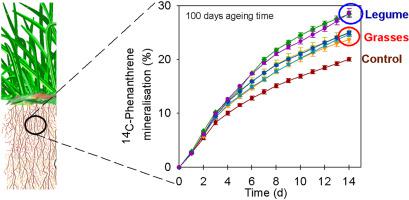International Biodeterioration & Biodegradation ( IF 4.1 ) Pub Date : 2020-12-23 , DOI: 10.1016/j.ibiod.2020.105164 Gabriela M. Vázquez-Cuevas , Carly J. Stevens , Kirk T. Semple

|
Plants and their roots, in particular, may be important in stimulating microbial degradation of organic contaminants in soil. It is also known that bioaccessibility is important in controlling the biodegradation of organic contaminants in soil. This study aimed to assess the impact of plant roots on the biodegradation and bioaccessibility of 14C-phenanthrene in soil in the presence of plant root biomass. To do this, changes in the 14C-phenanthrene mineralisable and hydroxypropyl-β-cyclodextrin (HPCD) extractable fractions were evaluated. After 1, 25, 50 and 100 days of PAH-soil contact time, 12/14C-phenanthrene-spiked soil was amended with roots from two grasses and one legume. Mineralisation and HPCD extractability of 14C-phenanthrene were measured after 1, 21 and 42 days PAH-root-soil contact time. Findings revealed that mineralisation of 14C-phenanthrene was enhanced following the amendment with plant root biomass regardless their species or form, especially in the soils that been aged for ≥50 days soil-PAH contact time. Overall, this study showed that greater levels of phenanthrene biodegradation may be achieved by incorporating root biomass into the contaminated soil, particularly where indigenous catabolic activity has developed. The findings reported here contribute to the understanding of how plant root biomass may impact on contaminant bioaccessibility and stimulate the more effective indigenous biodegradation of hydrocarbons in soil.
中文翻译:

根部污染土壤中14 C-菲的生物可及性
在刺激土壤中有机污染物的微生物降解方面,植物及其根特别重要。还已知生物可及性对于控制土壤中有机污染物的生物降解很重要。这项研究旨在评估在植物根系生物量存在的情况下,植物根系对土壤中14 C-菲的生物降解和生物可及性的影响。为此,评估了14 C菲可矿化和羟丙基-β-环糊精(HPCD)可萃取级分的变化。在PAH与土壤接触1、25、50和100天后,用来自两个草和一个豆科植物的根对12/14 C菲加标土壤进行了改良。14的矿化和HPCD可萃取性在PAH-根-土壤接触时间1、21和42天后测量C-菲。研究结果表明,植物根系生物量的改变会增加14 C-菲的矿化作用,无论其物种或形式如何,特别是在土壤中与PAH接触时间≥50天的土壤中。总体而言,这项研究表明,通过将根生物量掺入受污染的土壤中,尤其是在已开发出土著分解代谢活性的地方,可以实现更高水平的菲生物降解。此处报道的发现有助于人们了解植物根系生物量可能如何影响污染物的生物可利用性,并促进土壤中碳氢化合物的更有效的本地生物降解。









































 京公网安备 11010802027423号
京公网安备 11010802027423号